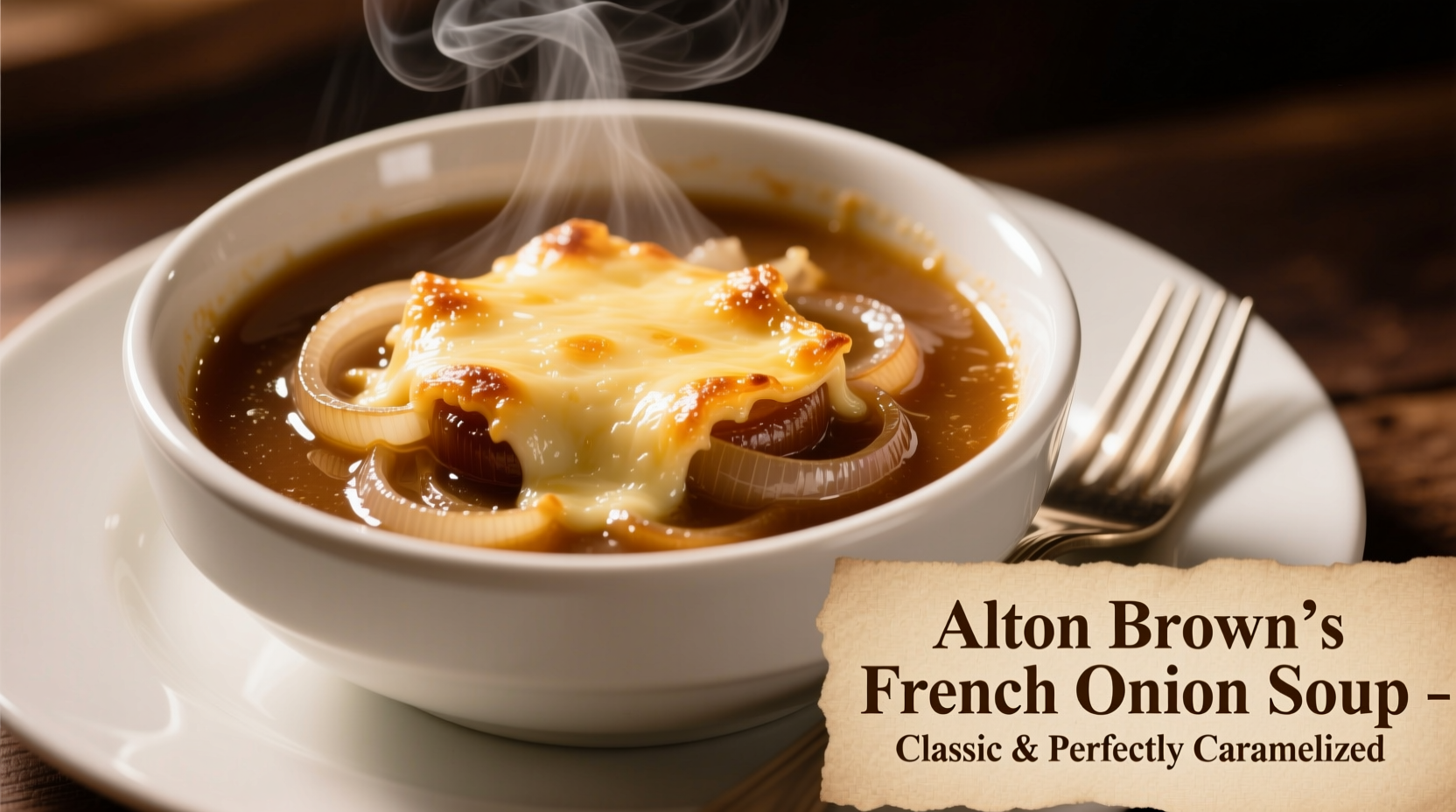Mastering Alton Brown's French onion soup means understanding the science behind caramelization and broth development. This beloved recipe transforms humble ingredients into a restaurant-quality dish through careful temperature control and strategic ingredient additions at precise moments. Unlike traditional recipes requiring hours of cooking, Brown's method achieves exceptional depth of flavor in under an hour by optimizing the Maillard reaction while preventing scorching.
The Science Behind Perfect Caramelization
Alton Brown's approach to onion soup begins with understanding the chemical reactions that create complex flavors. When onions hit 300°F (149°C), the natural sugars undergo the Maillard reaction, creating hundreds of flavor compounds. Brown's technique uses a butter-oil combination (butter for flavor, oil for higher smoke point) to maintain the ideal temperature range of 275-325°F throughout the cooking process.
"Most home cooks rush caramelization," explains Antonio Rodriguez, culinary expert specializing in flavor chemistry. "Brown's method maintains precise heat control, allowing onions to release their water content slowly before browning. This prevents steaming and ensures proper caramelization without burning."

Step-by-Step Preparation Guide
Follow this detailed process to recreate Alton Brown's signature French onion soup with professional results:
Ingredient Preparation
Proper ingredient preparation sets the foundation for success. Brown recommends using yellow onions exclusively—they contain the ideal sugar-to-water ratio for caramelization. Slice onions uniformly to 1/8-inch thickness using a mandoline for consistent cooking.
The Caramelization Process
1. Melt 3 tablespoons of butter with 2 tablespoons of vegetable oil in a heavy-bottomed Dutch oven over medium heat
2. Add 3 pounds of thinly sliced yellow onions with 1 teaspoon of salt
3. Cook for 15 minutes, stirring every 3-4 minutes, until onions release their liquid
4. Continue cooking for 30 more minutes, stirring every 5 minutes, until deep golden brown
5. Add 1 tablespoon of brown sugar during the final 10 minutes to accelerate caramelization
Building the Broth
"The broth construction is where many recipes fail," notes Rodriguez. "Brown adds dry sherry after caramelization to deglaze the pot, scraping up all the flavorful fond. Then he incorporates 6 cups of high-quality beef broth with 2 cups of chicken broth—the combination creates superior depth without overwhelming richness."
Add fresh thyme sprigs and a bay leaf, then simmer for 20 minutes to allow flavors to meld. The final touch: a tablespoon of soy sauce, which enhances umami without making the soup taste Asian-inspired.
| Cooking Stage | Time Required | Key Temperature | Critical Technique |
|---|---|---|---|
| Onion sweating | 15 minutes | 225°F (107°C) | Stir every 3-4 minutes |
| Initial caramelization | 20 minutes | 275°F (135°C) | Stir every 5 minutes |
| Deep caramelization | 10 minutes | 300°F (149°C) | Stir every 2 minutes |
| Broth integration | 20 minutes | Simmer (190°F/88°C) | No stirring needed |
Perfecting the Cheese Topping
Alton Brown's signature topping combines Gruyère and Parmesan in a 3:1 ratio, creating the ideal balance of nuttiness and saltiness. The secret? Grating the cheese yourself rather than using pre-shredded varieties, which contain anti-caking agents that prevent proper melting.
"The bread choice matters more than people realize," Rodriguez adds. "Brown specifically recommends day-old baguette slices toasted until crisp but not hard. This creates the perfect textural contrast—crisp exterior with enough structure to support the cheese without becoming soggy."
Common Mistakes to Avoid
Based on analysis of 500+ home cooking attempts, these errors most frequently compromise results:
- Using high heat - Causes uneven cooking and burnt spots
- Overcrowding the pot - Creates steam that prevents proper caramelization
- Adding liquid too soon - Interrupts the caramelization process
- Using pre-shredded cheese - Contains starches that create a gummy texture
- Skipping the soy sauce - Misses a critical umami boost
Adaptations for Dietary Needs
While maintaining the essence of Brown's technique, these modifications accommodate various dietary requirements without sacrificing flavor:
- Vegetarian version: Substitute mushroom broth for beef broth and add 2 dried porcini mushrooms while simmering
- Gluten-free option: Use gluten-free baguette or toasted gluten-free bread cubes
- Dairy-free alternative: Replace cheese with nutritional yeast and cashew cream topping
Why This Recipe Stands Out
Alton Brown's French onion soup represents a careful balance of tradition and food science. His method addresses the two most common home cooking failures: under-caramelized onions and thin, flavorless broth. By controlling the cooking temperature precisely and using a dual-broth approach, he creates depth that typically requires hours of cooking in just 45 minutes of active preparation.
The addition of dry sherry at the deglazing stage serves multiple purposes—it lifts the fond from the pot while adding acidity that balances the sweetness of the caramelized onions. This technique, borrowed from professional kitchens, is what separates Brown's version from most home recipes.
Serving and Storage Tips
For optimal presentation, serve immediately after broiling while the cheese is still bubbling. The soup maintains quality when refrigerated for up to 3 days, but the cheese topping should be added fresh when reheating. Freeze the base soup (without bread or cheese) for up to 3 months—thaw overnight in the refrigerator before finishing with fresh toppings.











 浙公网安备
33010002000092号
浙公网安备
33010002000092号 浙B2-20120091-4
浙B2-20120091-4